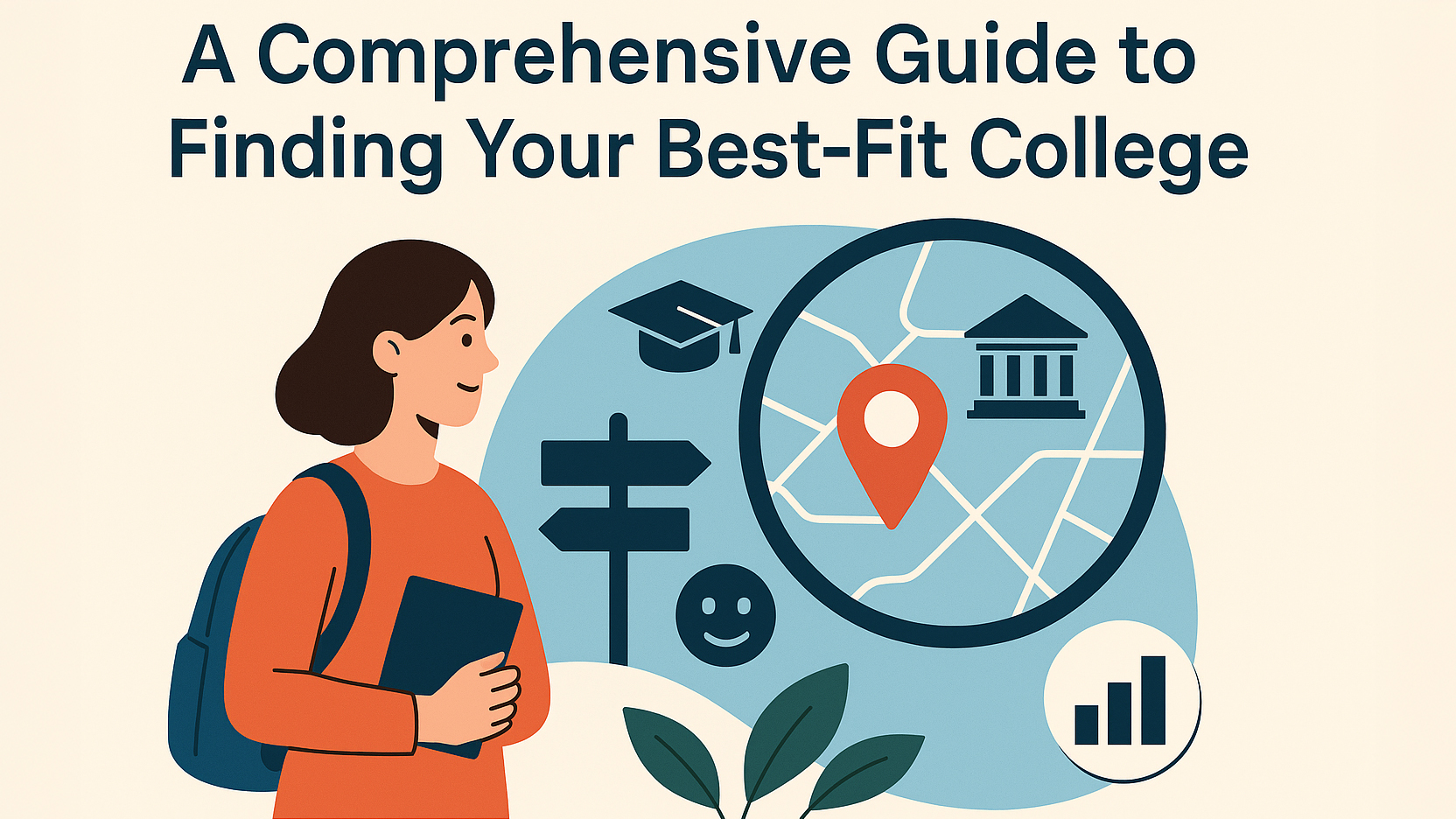Choosing where you will spend the next four years is a high-stakes decision that shapes your learning, finances, and future network. This guide shows you—step by step—how to choose a college by building a balanced college list that fits your academic profile and your life goals, without letting rankings or rumors derail clear thinking.

Maria, a rising senior at Lamar High School, stared at the spreadsheet open on her laptop at Common Bond Café in Montrose. With college deadlines looming, her anxiety grew as quickly as the afternoon traffic on Westheimer. She knew Rice University was her dream school—just minutes from home, with its vibrant residential colleges and exceptional research opportunities—but she knew she couldn’t rely on just one dream. As her counselor constantly reminded her, it was important to explore more realistic options.
Over iced lattes, Maria and her mother talked through options beyond Rice, but soon the conversation stalled. Texas A&M had great traditions, and the University of Houston’s Honors College seemed promising, yet Maria felt unsure if they truly fit her vision for college life. Even with suggestions from her counselor, the spreadsheet in front of her felt overwhelming rather than reassuring.
She sighed, feeling stuck. How would she know which schools were right for her? Where was she supposed to start? The stress of the unknown felt heavier with each passing day, leaving her uncertain about how to proceed.
Why Match and Fit Both Matter When Applying to College
Choosing the right college involves finding schools that match both your academic abilities and your personal preferences. “Match” ensures you’ll be academically challenged but not overwhelmed, while “fit” means you’ll genuinely feel comfortable and motivated within the campus community. Prioritizing both will maximize your chances of thriving academically and personally.
Academic Match
- Safety School: your GPA and scores are well above the median → acceptance is very likely.
- Target School: your numbers sit near the middle 50% of admits → odds are solid but not guaranteed.
- Reach School: your academics trail the median or the school is extremely selective → still worth a shot if the fit is right.
Personal & Social Fit
Fit covers culture, support, location, size, and daily life on campus. A perfect academic match can still disappoint if the environment leaves you isolated or uninspired. When applying to college, make sure the college’s values, pace, and people resonate with who you are and who you want to become. Learning about college campus culture is paramount to knowing how to choose a college.
Common Misconceptions
Families often approach college selection guided by myths rather than facts, leading to avoidable stress and disappointment when applying to college. Recognizing these common misconceptions early—such as equating prestige with success or underestimating financial considerations—allows students to create more realistic and satisfying college lists.
- Prestige equals success. Long-term studies show engagement—not brand name—is what drives career satisfaction and earnings.
- Money can wait. Delaying cost analysis leads to painful surprises when award letters arrive.
- Campus life is “Extra.” Poor social fit is a top reason students transfer or drop out.
Building a Balanced College List
A balanced college list strategically blends safety, target, and reach schools to provide optimal choices when applying to college, without unnecessary risk. Including schools from each category ensures you’ll have excellent options, regardless of how competitive the admissions landscape becomes. Whether you use a digital college list template or write on physical paper, your list should follow these guidelines. 
Safety Schools
- Admit chance above 80% based on published data.
- Programs you would be proud to attend.
- Net price your family can cover without heroic loans.
Target Schools
- 40 – 70% admit probability for your stats.
- Resources, mentoring, and outcomes that align with your goals.
Reach Schools
- Admit odds below 40%, but a unique upside you cannot replicate elsewhere.
- A crystal-clear financial plan if the acceptance comes through.
Holistic Campus Factors
Considering holistic campus factors beyond academics ensures you’ll enjoy the overall college experience. Evaluating aspects like campus life, residential quality, and mental health resources can profoundly influence your daily happiness, social connections, and long-term success — all crucial elements when considering how to choose a college.
- Academics: research access, honors tracks, and faculty availability.
- Campus Life: clubs, traditions, and leadership pipelines.
- Housing & Dining: quality, guarantees, and special-interest options.
- Mental Health & Wellness: counselor ratios, peer programs, and inclusive policies.
Undermatching: What It Is and How to Avoid It
High-achieving students—especially those from low-income or first-generation backgrounds—sometimes enroll in colleges far below their academic level. They miss out on challenge, support, and lifelong earning power. Undermatching starts early, causing students to ignore would-be target schools entirely when applying to college. Understanding undermatching and proactively countering it with accurate information and strategic guidance ensures you’ll select colleges aligned with your true potential.
- Get accurate data. Use each college’s Common Data Set, not hearsay.
- Visit – virtually or in person. Seeing the campus culture shrinks impostor fears.
- Seek mentors. Counselors and near-peer guides can recalibrate expectations and highlight resources.

Holistic Admissions Explained
Holistic admissions means colleges evaluate more than just your test scores and grades. Understanding how to optimize your essays, recommendations, extracurricular activities, and demonstrated interest helps you present a compelling narrative that highlights your strengths beyond academics.
- Essays: show growth, curiosity, and authentic voice.
- Recommendations: choose teachers who can cite concrete moments of impact.
- Activities: depth beats breadth – sustained effort and measurable results draw attention.
- Demonstrated Interest: events, tailored emails, and well-researched supplements prove you care.
- Identity: show them who you are, make it clear what you want, tell your story.
Practical Steps to Craft Your College List
Building a balanced college list requires methodical reflection, targeted research, organized tracking, and strategic refinement. By following structured, practical steps when applying to college, you’ll ensure your final college choices genuinely reflect your goals, values, and realistic opportunities.
- Reflect. Rank academics, location, culture, and cost in personal order of importance.
- Research. Dig through official stats, student reviews, and live Q&A sessions.
- Track. Log findings in a spreadsheet with columns for cost, admit rate, and gut-reaction score.
- Narrow. Keep 2 – 3 safeties, 3 – 5 matches, and 2 – 3 reaches you would love to attend.
- Review. Revisit the list quarterly; drop schools that no longer match evolving priorities.
College Financial Aid Strategy
Financial planning is crucial to avoid surprises and make attending your chosen college affordable. Understanding different types of aid, accurately calculating net price, and learning how to negotiate financial packages empowers you to make financially sound decisions throughout the admissions process.
Total Cost of Attendance vs. Net Price
- Include tuition, fees, housing, meals, books, travel, and personal expenses.
- Run each college’s Net Price Calculator (NPC) for a reality-based estimate.
Automatic vs. Competitive Merit Awards
- Automatic: triggered solely by GPA or test scores – no extra application.
- Competitive: require essays, interviews, or portfolios; deadlines often arrive months earlier than regular admission.
Aid Displacement Risks
- Some colleges reduce need-based grants dollar-for-dollar when you bring in outside scholarships.
- Ask each financial aid office how private awards affect your package before you commit.
Appeals & Negotiation Workflow
- Compare official offers side by side.
- Document any changes in family finances – layoffs, medical bills, or other hardships.
- Email the aid office with a concise, polite request for reconsideration.
- Attach proof and, if possible, a competing offer from another institution.
- Follow up once; accept the best net price with eyes wide open.
Special Trends to Watch When Applying to College
Knowing how to choose a college is increasingly becoming more complicated and confusing. Emerging trends like test-optional policies and shifting perceptions about institutional prestige are reshaping college admissions. Staying informed about these trends allows you to strategically adapt your application approach and college choices to maximize outcomes.
Prestige vs. Outcomes
Elite brands open doors, but engagement and major matter more for most students. For first-generation or under-represented applicants, selective colleges can offer extra mentorship and networks – but only if the fit and finances also work.
Test-Optional Landscape
- Submit scores that land at or above a school’s 50th percentile.
- If your numbers fall short, lean into essays, grades, and rigor instead.
Conclusion: Own Your Search
Choosing your college is a major step toward independence and personal growth. How to choose a college is complicated; to succeed, it is important to know how to compare colleges in the first place. Ultimately, owning your search—balancing data-driven decisions with self-awareness—ensures you’ll attend a school where you can confidently succeed academically, socially, and financially.
When applying to college, balance ambition with realism, data with intuition, and cost with value. A deliberate, well-researched list maximizes acceptances and minimizes regrets – while keeping you in control of both your wallet and your future. Click here to learn more about how we can help you on your journey.
College Application Checklist

Before finalizing your applications, use this quick-reference checklist to confirm that your balanced college list is truly balanced and carefully vetted. Reviewing these points—integral to any college list template—ensures you’ve covered critical bases and are positioned for successful admissions outcomes.
- List includes 2 – 3 safety schools, 3 – 5 target schools, and 2 – 3 reach schools.
- Every school passes your academic, social, and cost tests.
- College net-price calculations completed for all options.
- Application timeline, essays, and recommendations scheduled.
Frequently Asked Questions
This FAQ addresses common concerns students and families have when finalizing their college lists. Quickly find answers to essential questions on application strategy, financial planning, and best practices for demonstrating your interest to colleges.
- All
- Academic Profile & Testing
- Demonstrated Interest & Interviews
- Essays & Personal Statements
- Financial Aid & Affordability
- Planning & Fit
Send test scores to test-optional schools when they enhance your application – typically at or above the school’s median. Otherwise, withhold and bolster essays, grades, and course rigor.
File an appeal with updated documentation such as job-loss notices or medical bills. Most colleges will re-evaluate need-based aid.
Attend virtual sessions, visit campus, email regional reps, and reference specific programs in your supplements.
Revisit campuses (ideally, in-person), compare financial aid, talk with current/former students, and—above all—trust your gut.
The biggest essay mistake is having generic answers (e.g., “I’ve always loved science”) or listing achievements without reflection.
There is nothing wrong with seeking help for essay editing, but the “voice” of the essay must be authentically yours. Avoid over-polishing—admissions officers spot inauthenticity.
They’re rarely decisive but can provide context. Treat them as conversations, not interrogations.
Authenticity! Share a specific story that reveals your values, growth, or perspective.
The optimal size of college depends on your goals: small = personalized attention; large = more resources/networks.
Most colleges don’t require declaring until sophomore year, but your stated major on your application should fit your sales pitch.
Yes! Politely appeal with competing offers or new financial circumstances.
Submit the FAFSA and/or CSS Profile. Aid is based on need (grants, loans) and merit (scholarships).
Yes! Colleges can rescind offers if grades drop significantly.
No, but they show rigor. Focus on excelling in courses available to you.
Yes, most colleges and universities absolutely care about demonstrated interest. There are multiple ways to demonstrate interest: attend virtual tours (virtual or in-person), email admissions reps, or engage on social media to show enthusiasm. If you are deferred or waitlisted, consider sending a Letter of Continued Interest.
Yes and no. You can reuse parts of essays or follow similar outlines, but you should always tailor them to each school’s prompts and values. Never mention the wrong college in an essay!
– ED: Binding commitment if accepted (apply to 1 school).
– EA: Non-binding early application (multiple schools).
– RD: Standard deadline (no restrictions).
Start exploring interests and building strong academic habits early (even in 9th grade), but formal application prep (essays, resumes, etc.) begins in junior year.
Most students succeed with 8 – 12 well-researched schools: 2 – 3 safeties, 3 – 5 matches, and 2 – 3 reaches. Highly accomplished students might consider applying to a higher proportion of reach schools, but every student should balance out their list with colleges of varied selectivity.
Every high school has a different way of calculating grades, which makes it difficult to use GPA as a metric for college admissions. Some colleges provide aggregate GPA data for recently admitted students, but this is nowhere near as widely available as test score data.
Some colleges standardize GPA themselves through a recalculation process, which can provide a clearer point of comparison for students. Others focus on holistic review of student transcripts, with an emphasis of rigor of curriculum – that is, they primarily care about which courses your student took, how challenging those courses are relative to what was available to them, and what grade is next to each course on the transcript.
Many colleges switched to a test-optional policy with the onset of COVID-19. However, some colleges (including MIT) have switched back to a test-required policy, so we’d recommend checking the requirements of each university on your college list. On the opposite end of the spectrum, a handful of colleges have committed to a test-blind policy (including the University of California system), meaning that they are removing test scores from consideration entirely.
In general, we do recommend preparing for either the SAT or ACT, even if many of your student’s target colleges are test-optional. If a student can achieve a score that falls near or above the median for typical students admitted to any given college, then submitting scores will only serve to benefit them. Your student can also always choose to submit their score to some schools and withhold them from others.
Generally speaking, colleges do not make value judgments about the extracurricular activities a student chooses to pursue. They do, however, value quality over quantity; they look for students who commit to particular activities for the long-term and rise to leadership roles within them.
Ideally, your student’s extracurriculars should reflect their genuine interests and passions. If they sincerely enjoy a particular activity, they’ll have a better time working hard to improve themselves, achieve awards, and maybe earn leadership positions. Extracurriculars are also a great way for students to explore new interests that may grow into passions – or even career paths.
College admissions officers assess applications holistically, meaning they evaluate the “whole” student. No factor (including grades, test scores, or extracurriculars) is considered in a vacuum; rather, these pieces are all assessed in the context of each student’s unique background.
With that being said, a student’s academic record (including their grades and course selections) tend to be the most important part of each application. College vary in terms of which factors they consider and how they weigh them; most colleges provide insight into these factors on their Common Data Set document (try searching the web for “[College Name] + Common Data Set”).




